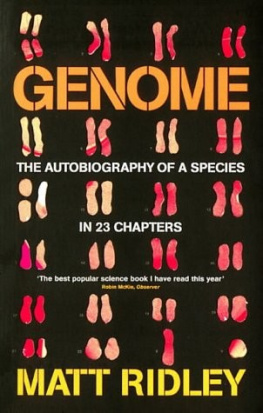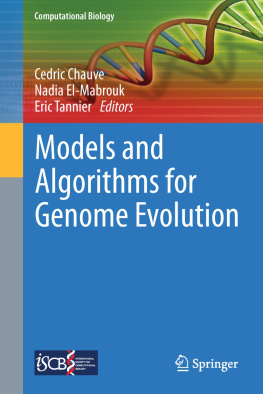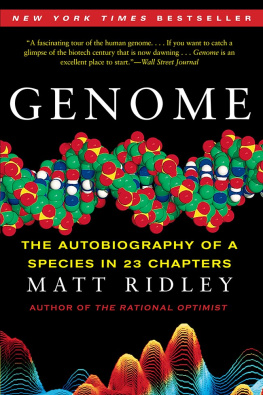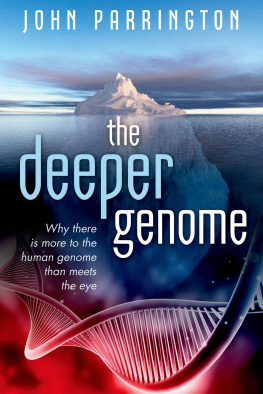Gregory - The Evolution of the Genome
Here you can read online Gregory - The Evolution of the Genome full text of the book (entire story) in english for free. Download pdf and epub, get meaning, cover and reviews about this ebook. year: 2005, publisher: Elsevier Science, genre: Children. Description of the work, (preface) as well as reviews are available. Best literature library LitArk.com created for fans of good reading and offers a wide selection of genres:
Romance novel
Science fiction
Adventure
Detective
Science
History
Home and family
Prose
Art
Politics
Computer
Non-fiction
Religion
Business
Children
Humor
Choose a favorite category and find really read worthwhile books. Enjoy immersion in the world of imagination, feel the emotions of the characters or learn something new for yourself, make an fascinating discovery.

The Evolution of the Genome: summary, description and annotation
We offer to read an annotation, description, summary or preface (depends on what the author of the book "The Evolution of the Genome" wrote himself). If you haven't found the necessary information about the book — write in the comments, we will try to find it.
Gregory: author's other books
Who wrote The Evolution of the Genome? Find out the surname, the name of the author of the book and a list of all author's works by series.
The Evolution of the Genome — read online for free the complete book (whole text) full work
Below is the text of the book, divided by pages. System saving the place of the last page read, allows you to conveniently read the book "The Evolution of the Genome" online for free, without having to search again every time where you left off. Put a bookmark, and you can go to the page where you finished reading at any time.
Font size:
Interval:
Bookmark:
- Tables in Chapter 1
- Tables in Chapter 2
- Tables in Chapter 3
- Tables in Chapter 4
- Tables in Chapter 7
- Tables in Chapter 8
- Tables in Chapter 9
- Tables in Chapter 10
- Figures in Chapter 1
- Figures in Chapter 2
- Figures in Chapter 3
- Figures in Chapter 4
- Figures in Chapter 5
- Figures in Chapter 6
- Figures in Chapter 7
- Figures in Chapter 8
- Figures in Chapter 9
- Figures in Chapter 10
- Figures in Chapter 11
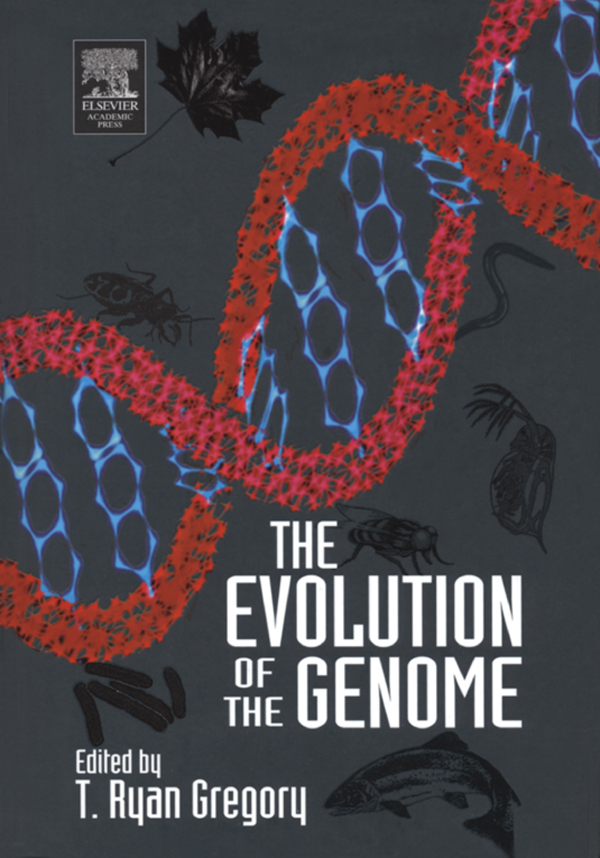
T. Ryan Gregory, Ph.D.
Department of Entomology, The Natural History Museum, London, UK
Academic Press
MICHAEL D. BENNETT, Ph.D. , Jodrell Laboratory, Royal Botanic Gardens, Kew, UK
]
JUAN PEDRO M. CAMACHO, Ph.D. , Departamento de Gentica, Universidad de Granada, Granada, Spain
]
ROB DESALLE, Ph.D. , Division of Invertebrate Zoology, American Museum of Natural History, New York, USA
]
ALAN FILIPSKI, Ph.D. , Center for Evolutionary Functional Genomics, Arizona Biodesign Institute, Arizona State University, Tempe, Arizona, USA
]
T. RYAN GREGORY, Ph.D. , Department of Entomology, The Natural History Museum, London, UK
]
MARGARET G. KIDWELL, PH.D. , Department of Ecology and Evolutionary Biology, The University of Arizona, Tuscon, Arizona, USA
]
SUDHIR KUMAR, Ph.D. , School of Life Sciences, Arizona State University, Tempe, Arizona, USA
]
ILIA J. LEITCH, Ph.D. , Jodrell Laboratory, Royal Botanic Gardens, Kew, UK
]
BARBARA K. MABLE, Ph.D. , Division of Environmental and Evolutionary Biology, University of Glasgow, Glasgow, UK
]
AXEL MEYER, Ph.D. , Department of Biology, University of Konstanz, Konstanz, Germany
]
JEROEN RAES, Ph.D. , Department of Plant Systems Biology, Flanders Interuniversity Institute for Biotechnology (VIB), Ghent University, Gent, Belgium
]
DOUGLAS E. SOLTIS, Ph.D. , Department of Botany, University of Florida, Gainesville, Florida, USA
]
PAMELA S. SOLTIS, Ph.D. , Florida Museum of Natural History, University of Florida, Gainesville, Florida, USA
]
JENNIFER A. TATE, Ph.D. , Florida Museum of Natural History, University of Florida, Gainesville, Florida, USA
]
JOHN S. TAYLOR, Ph.D. , Department of Biology, University of Victoria, Victoria, British Columbia, Canada
]
YVES VAN DE PEER, Ph.D. , Department of Plant Systems Biology, Ghent University, Gent, Belgium
]
It has been said that the preface is the most important part of a book, because even the reviewers will read it. That strikes me as a lot of pressure to put on such a small fraction of a book, made no less disconcerting by the fact that the preface can actually be rather challenging to write. How does one encapsulate, in only a few pages, a book that covers (and integrates) as many topics, involved the input of as many people, and has taken as much work to prepare as this one? The only strategy that comes to mind is to follow the old adage that one should stick to writing what one knows best. As such, it seems reasonable (and actually quite appropriate) to discuss this book in biological terms.
A central theme of this volume is that genomes represent a distinct and legitimate level of biological organization, with their own inherent properties and unique evolutionary histories. Books about genomes, too, are organized entities that evolve in sometimes unpredictable ways, and are subject to the same general processes as biological individuals. What is editing, really, but an example of intellectual selection, whereby the author proposes and the editor disposes (or at least ruthlessly modifies)? As with life at large, the evolution of this book also involved healthy doses of morphological constraint (especially in regard to length), the necessary coordination of parts, hybridization of data from the study of very different taxonomic groups, horizontal transfer and exaptation of concepts among disciplines, and more than a little quirky historical contingency.
The evolution of any entity, living or literary, is a combination of general principles (acting at several levels of organization) and unique historical particulars. The convoluted particulars of this books genesis are as follows. In 2002, I ventured to Washington, DC to attend a conference. While there, I was kindly hosted by my friend and colleague Grace Wyngaard, whose husband, Roy McDiarmid, is a curator of herpetology at the Smithsonian Institution. Also at the conference was Chuck Crumly, then a senior editor at Academic Press, who had also trained as a herpetologist and was an old acquaintance of Roys. Through this connection, Chuck approached me with the notion of preparing a book on genome evolution for Academic Press.
Lacking any comparative data, I can only speculate as to how typical the rest of the books history is: Rookie editorial hopeful manages to assemble an all-star list of authors and gets a book contract; original publisher is phagocytosed by another company; there ensues a chaotic series of comings and goings on the publishing team involved with the book (including the departure of Chuck Crumly); some authors who planned to contribute are unable to; the chapter list is juggled and reshuffled, and other equally stellar contributors graciously agree to join the revised project; and in the end, a book emerges that bears at least a modest resemblance to the one discussed over a lunchtime meeting more than two years earlier.
Now that the book has come into being, it is worthwhile to consider some aspects of its ecology and morphologythat is to say, the niche it is meant to occupy and the ways in which it is adapted to do so.
Speaking from experience, I can attest that the primary literature of genome biology is, shall we say, less than readily accessible. It can be a significant challenge to follow developments in ones own specialized subdiscipline, and a near impossibility to obtain a broad view of genome evolution at large. The chasms separating researchers working on different genomic questions or with different taxa are as wide as ever, and those dividing the various branches of the life sciences seem to be getting wider. This can be a major barrier to understanding the context and importance of genome evolution, a problem that is particularly acute for newcomers.
The chapters in this book are meant to provide comprehensive summaries of the underlying concepts, histories, current statuses, and future prospects of the major fields of genomic inquiry. Too often, these conceptual and historical underpinnings are overlooked as new discoveries come to dominate discussions of these topics. Overall, this book is aimed at the up-and-coming genome generationadvanced graduate students, postdocs, and young faculty membersalthough it should also serve as a valuable resource for existing experts in these and related fields. Put explicitly, it is written for the people who are, and will be, shaping the future of genome biology. It therefore provides a map to the otherwise bewildering maze of literature on genome evolution, seeks to build much-needed bridges between divergent disciplines, and, perhaps most importantly, stresses the big picture. In some cases, the subject of a given chapter has never been reviewed before, and, as such, is treated as comprehensively as possible. In others, the subject could be (and in some cases
Font size:
Interval:
Bookmark:
Similar books «The Evolution of the Genome»
Look at similar books to The Evolution of the Genome. We have selected literature similar in name and meaning in the hope of providing readers with more options to find new, interesting, not yet read works.
Discussion, reviews of the book The Evolution of the Genome and just readers' own opinions. Leave your comments, write what you think about the work, its meaning or the main characters. Specify what exactly you liked and what you didn't like, and why you think so.







